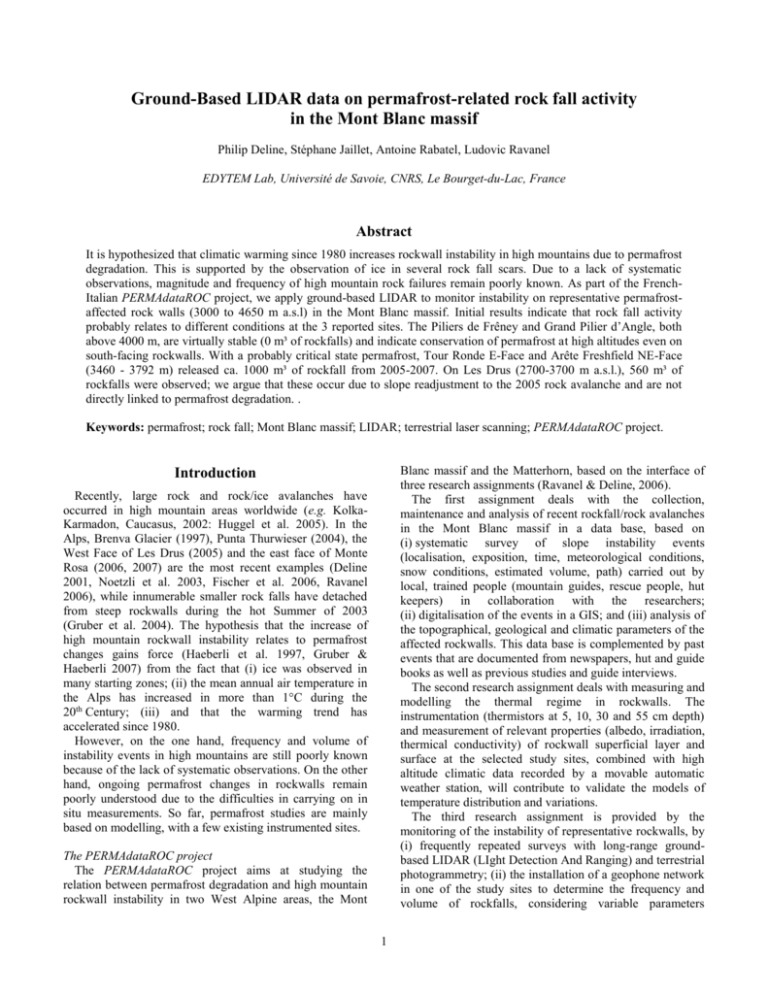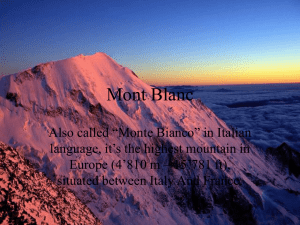Philip Deline, Stéphane Jaillet, Antoine Rabatel, Ludovic Ravanel
advertisement

Ground-Based LIDAR data on permafrost-related rock fall activity in the Mont Blanc massif Philip Deline, Stéphane Jaillet, Antoine Rabatel, Ludovic Ravanel EDYTEM Lab, Université de Savoie, CNRS, Le Bourget-du-Lac, France Abstract It is hypothesized that climatic warming since 1980 increases rockwall instability in high mountains due to permafrost degradation. This is supported by the observation of ice in several rock fall scars. Due to a lack of systematic observations, magnitude and frequency of high mountain rock failures remain poorly known. As part of the FrenchItalian PERMAdataROC project, we apply ground-based LIDAR to monitor instability on representative permafrostaffected rock walls (3000 to 4650 m a.s.l) in the Mont Blanc massif. Initial results indicate that rock fall activity probably relates to different conditions at the 3 reported sites. The Piliers de Frêney and Grand Pilier d’Angle, both above 4000 m, are virtually stable (0 m³ of rockfalls) and indicate conservation of permafrost at high altitudes even on south-facing rockwalls. With a probably critical state permafrost, Tour Ronde E-Face and Arête Freshfield NE-Face (3460 - 3792 m) released ca. 1000 m³ of rockfall from 2005-2007. On Les Drus (2700-3700 m a.s.l.), 560 m³ of rockfalls were observed; we argue that these occur due to slope readjustment to the 2005 rock avalanche and are not directly linked to permafrost degradation. . Keywords: permafrost; rock fall; Mont Blanc massif; LIDAR; terrestrial laser scanning; PERMAdataROC project. Blanc massif and the Matterhorn, based on the interface of three research assignments (Ravanel & Deline, 2006). The first assignment deals with the collection, maintenance and analysis of recent rockfall/rock avalanches in the Mont Blanc massif in a data base, based on (i) systematic survey of slope instability events (localisation, exposition, time, meteorological conditions, snow conditions, estimated volume, path) carried out by local, trained people (mountain guides, rescue people, hut keepers) in collaboration with the researchers; (ii) digitalisation of the events in a GIS; and (iii) analysis of the topographical, geological and climatic parameters of the affected rockwalls. This data base is complemented by past events that are documented from newspapers, hut and guide books as well as previous studies and guide interviews. The second research assignment deals with measuring and modelling the thermal regime in rockwalls. The instrumentation (thermistors at 5, 10, 30 and 55 cm depth) and measurement of relevant properties (albedo, irradiation, thermical conductivity) of rockwall superficial layer and surface at the selected study sites, combined with high altitude climatic data recorded by a movable automatic weather station, will contribute to validate the models of temperature distribution and variations. The third research assignment is provided by the monitoring of the instability of representative rockwalls, by (i) frequently repeated surveys with long-range groundbased LIDAR (LIght Detection And Ranging) and terrestrial photogrammetry; (ii) the installation of a geophone network in one of the study sites to determine the frequency and volume of rockfalls, considering variable parameters Introduction Recently, large rock and rock/ice avalanches have occurred in high mountain areas worldwide (e.g. KolkaKarmadon, Caucasus, 2002: Huggel et al. 2005). In the Alps, Brenva Glacier (1997), Punta Thurwieser (2004), the West Face of Les Drus (2005) and the east face of Monte Rosa (2006, 2007) are the most recent examples (Deline 2001, Noetzli et al. 2003, Fischer et al. 2006, Ravanel 2006), while innumerable smaller rock falls have detached from steep rockwalls during the hot Summer of 2003 (Gruber et al. 2004). The hypothesis that the increase of high mountain rockwall instability relates to permafrost changes gains force (Haeberli et al. 1997, Gruber & Haeberli 2007) from the fact that (i) ice was observed in many starting zones; (ii) the mean annual air temperature in the Alps has increased in more than 1°C during the 20th Century; (iii) and that the warming trend has accelerated since 1980. However, on the one hand, frequency and volume of instability events in high mountains are still poorly known because of the lack of systematic observations. On the other hand, ongoing permafrost changes in rockwalls remain poorly understood due to the difficulties in carrying on in situ measurements. So far, permafrost studies are mainly based on modelling, with a few existing instrumented sites. The PERMAdataROC project The PERMAdataROC project aims at studying the relation between permafrost degradation and high mountain rockwall instability in two West Alpine areas, the Mont 1 2 NINTH INTERNATIONAL CONFERENCE ON PERMAFROST (altitude, aspect, slope angle, lithology, fracturing, shadow effect, height drop). Italian (CNR-IRPI Torino, ARPA Valle d’Aosta and FMS Courmayeur) and French (EDYTEM Lab) partners are involved in the PERMAdataROC project, with collaboration with the GGG of University of Zürich. Here we present initial results of the monitoring of the instability of rockwalls at three sites in the Mont Blanc massif since 2005. Study area The Mont Blanc massif covers an area of approximately 350 km², 40 % of which are glacierized. It reaches its highest point at 4808 m a.s.l., but many of its granitic, fractured faces, peaks and aiguilles stand well above 3000 m: the water divide between Rhône and Pô basins is a 35 km long crest line which always exceeds 3300 m and is often higher than 4000 m. Being one of the most active uplift spots in the Alps (>1.5 mm.an-1), the massif is not only characterized by very high but also steep faces and rockwalls. Seven study sites from 3000 to 4650 m with different aspects were selected in the Mont Blanc massif within the PERMAdataROC project (fig. 1): the West Face of Les Drus, a >70° rockwall between 2700 and 3700 m affected by a series of rock falls since 1950 with increasing magnitude until June 2005, when collapse of the Pilier Bonatti generated a rock avalanche of > 250,000 m3 (fig. 2) (Ravanel 2006); the surveyed area at Les Drus is between 3000 and 3700 m; the Piton Central of the Aiguille du Midi Figure 2. Upper part of the West face of Les Drus. The upper part of the 2005 rock avalanche scar is delimited by the white line. To survey the face, the ground-based LIDAR is set up on Les Flammes de Pierre (crest on bottom right). Figure 1. Location map of GB-LIDAR surveyed sites in the Mont Blanc massif within the framework of the PERMAdataROC project. 1: Drus; 2: Aiguille du Midi; 3: Tour Ronde-Arête Freshfield; 4: Aiguilles d’Entrèves; 5: Grand Flambeau; 6: Piliers du Frêney-Grand Pilier d’Angle; 7: Aiguilles Blanches de Peuterey; 8: Vallon du Miage. Largest glaciers are highlighted. This paper presents initial results from sites 1, 3, and 6. (3770 - 3842 m) which towers above the cable car station, with all aspects; the east face of the Tour Ronde, and the NE-facing Arête Freshfield which develops at the south (3460 - 3792 m), where rockfalls have been active since several years; the west face of the Aiguilles d’Entrèves (3490 - 3591 m); the Grand Flambeau (3410 - 3561 m), close to the Helbronner cable car station, with all aspects; DELINE ET AL.3 the east-facing Piliers de Frêney (4000 - 4650 m) and the south face of the Grand Pilier d’Angle (4050 - 4308 m), on the south side of Mont Blanc summit; the NW face of the Aiguille Blanche Nord de Peuterey (4000 - 4103 m). These high elevation sites are complemented by a low-elevation control site (2200 - 2700 m) without permafrost, on the SWfacing side of the Vallon du Miage. Methods Since June 2005, ground-based LIDAR measurements are realised seasonally (summer/autumn) or annually at the eight sites in the Mont Blanc massif, using helicopter or cable cars for access. Data are processed for calculating high-resolution (centimeter-scale) triangulated irregular networks (TIN). Volumetric changes, extracted on the rock faces by comparing the successive TINs, represent the fallen rocks between the measurement periods (Ravanel & Deline, 2006). LIDAR survey LIDAR measurements are performed using an Optech ILRIS 3D ground-based LIDAR. This laserscanner works at distances of up to 800 m if surface reflectivity and visibility are good. The angle of view is 40° × 40° and the sampling rate reaches a maximum frequency of 2000 points per second. At a distance of 100 m the laser beam diameter is about 30 mm (perpendicular shot) and the accuracy on a flat surface is about 3-5 mm. The LIDAR point to point distances on the rockwalls we are surveying were ranging between 61 mm and 246 mm (in 2006 and 2007), on the closest and farthest areas respectively. Data processing Data processing (Rabatel et al., submitted) is realised using the InnovMetric PolyWorks software, with (i) alignment of individual point clouds using the IMAlign module: they are merged with a rototranslation matrix into a unique local reference system, after cleaning individual scans from outliers (Fig. 3); (ii) creation of the TIN using the IMMerge module. The computation of the fallen rock volume in a rockwall between two successive field work campaigns is achieved with the PolyWorks IMInspect module, which compares two point clouds and quantify the thickness changes. A reference plan is built and the volume between the surface topography and this plan is computed for each date. Error estimation The total uncertainty can be estimated by the quadratic sum of the different independent errors in the processing. (i) LIDAR error is 3-5 mm at 100 m (manufacturer data). (ii) TIN is interpolated from existing points of the global point cloud (set of 3D images). To merge it into a unified polygonal mesh, most parameters values are calculated using input point cloud values. Due to the average mesh Figure 3. Point clouds of the West Face of Les Drus derived from LIDAR surveys (left: October 2005; right: October 2006). The height of the 2005 rock avalanche scar here represented is 500 m. used, the TIN construction error is ca. 7 cm. (iii) To be compared, diachronous TINs have to be very overlapped. But because of very large TINs, there is a TIN overlapping error, which is 5 cm as measured by Polyworks. This yields an overall uncertainty of 9 cm, which is reduced by comparing directly the point clouds. Mask effect Masks result from (i) the topography of the rockwall (roofs, ledges, corners, spurs), (ii) the common scarcity of sites to set up the LIDAR (e.g. for the West Face of Les Drus, there is only one possible on Les Flammes de Pierre: Fig. 2), and (iii) the snow cover, which extension is different each year. Masks could represent an important part of the surface surveyed, and appear as holes in the TINs. This is particularly the case if there are no multiple viewing angles (Les Drus), or if the snow-ice cover is important (Peuterey). The Polyworks IMEdit module allows to reduce their extension. The hole area is first selected. A tool allows to fill the holes automatically using irregular triangles. Only the maximum distance between the vertices of a triangle has to be specified. The longer this distance the greater size of the plugged hole would result. Results We present initial results from three of the seven highelevation selected sites in the Mont Blanc massif: (i) the West Face of Les Drus; (ii) the east face of the Tour Ronde and the NW side of the Arête Freshfield; and (iii) the Piliers de Frêney and the south face of the Grand Pilier d’Angle (Table 1). 4 NINTH INTERNATIONAL CONFERENCE ON PERMAFROST Table 1. Rock fall data from LIDAR surveys (2005-2007) Site Drus (W face) Piliers de Frêney Grand Pilier d’Angle (S face) Period of measurement (d/m/y) 11/10/2005-11/10/2006 12/10/2006-24/09/2007 14/07/2005-10/10/2005 11/10/2005-30/06/2006 01/07/2006-13/10/2006 14/10/2006-12/10/2007 Tour Ronde (E fa- 13/07/2005-18/07/2006 ce) – Arête Fresh- 19/07/2006-12/10/2006 field (NE face) 13/10/2006-12/10/2007 Surface of surveyed area by LIDAR (m2) 70,500 115,600 67,400 Volume of rock falls (m3) Total 546 22 0 0 0 0 536 0 448 2 main 426 + 84 0 0 0 0 382 + 154 0 448 Mean rockwall retreat rate in surveyed area ( mm a-1) 7.7 0.3 0.0 0.0 0.0 0.0 8.4 0.0 6.6 Extreme distance of point to point on rockwall (mm) Not calculated 71-208 Not calculated Not calculated 61-246 61-246 Not calculated 75-207 75-207 West Face of Les Drus Comparison of October 2005 and October 2006 TINs reveals a detachment from the 2005 rock avalanche scar of height rock elements of a volume 1 m³: five boulders are ≤ 6 m³, and three are larger. At about 3600 m a.s.l., a notch of 29 × 10 × 1.8 m (426 m3) is present on the 2006 TIN; the rocks reached the small debris-covered glacier of Les Drus, at the foot of the West Face. Lower on the rockwall, two elements of 19 and 84 m3 also collapsed in this one year period. In total, 546 m3 of rock were released in the surveyed area between October 2005 and October 2006. The third survey, carried out at the end of September2007, shows a reduced rock fall activity over the period extending from October 2006 to September 2007: only one small rock fall occurred (22 m3), out of the 2005 scar. East face of La Tour Ronde-NE face of Arête Freshfield At the Tour Ronde, the evolution of the surface topography of the east face between July 2005 and July 2006 shows two main rock fall events, with a volume of 382 m3 (Fig. 4) and 154 m3 (scar main sizes are 17.5 × 7.8 × 4.3 m and 15.1 × 9.3 × 1.4 m, respectively). The total volume of these two rock fall reaches 536 m3. The comparison of LIDAR measurements for the second period, between July 2006 and October 2006, shows no significant change during the 2006 summer. During the third and last period of survey, no change was observed on the east face of Tour Ronde; on the other hand, at least two rock falls occurred on the NE side of the Arête Freshfield, which involved a set of large boulders (total volume: 448 m3) detached from a small area where bedrock is highly dislocated. . Figure 4. East face of the Tour Ronde TIN (detail). The view focuses on the area affected by the main rock fall between July 2005 (top box) and July 2006 (bottom box). Dimensions of the main scar (visible in bottom box circle) are 17.5 × 7.8 × 4.3 m, with a volume of 382 m3 (image size: ca. 45 m × 45 m). Piliers de Frêney-south face of Grand Pilier d’Angle Five successive LIDAR surveys performed since July 2005 display no change on the rockwalls during a period of 27 months including 3 summers. Mask effects are important, due to the rough topography of the area (large pillars separated by deep couloirs) and the unique site available to set up the ground-based LIDAR. Thus, only a part of this area is surveyed, but no significant rock fall was observed over the 115,000 m2 it represents. DELINE ET AL.5 Discussion and conclusions Results indicate that rock fall activity probably relates to different conditions at the three sites. At the West Face of Les Drus, the rock falls which occurred probably represent slope readjustment after the large rock avalanche of 2005 and are not directly related to permafrost degradation. For example, the detachment of 84 m3 between October 2005 and October 2006 is due to the fall of an individualized, hanging and poorly rooted slice. Moreover, the small pieces of rock (< 1 m3) identified between 2005 and 2006 were probably destabilized during the fall of the largest element (426 m3). Lastly, no rock fall occurred into the 2005 scar between 2006 and 2007: this suggests that the mesoscale slope readjustment in the scar is now achieved. But it is to note that a new permafrost active layer forms in the 2005 rock avalanche scar. On the other hand, at the East face of La Tour Ronde and on the NE side of the Arête Freshfield, the rock falls (20052006: 536 m3; 2006-2007: 448 m3) probably result from permafrost degradation. This is suggested both by (i) the high rock fall activity during the last years: the Normal route to the summit of Tour Ronde is no more used when snow cover has melted; and (ii) the modelling of the surface temperature of rockwalls in Alpine areas with similar weather conditions. For instance, mean annual surface temperature ranges between 2° and 4°C at Junfraujoch at 3500-3750 m a.s.l. for E/NE aspect (Gruber et al. 2004: Fig. 2), without taking into account the local topography of the rock faces. Contrary to the two others sites, the area of the Piliers de Frêney and the south face of the Grand Pilier d’Angle shows stable conditions. The results suggest that no or very occasional degradation of the permafrost occurs at very high altitude (> 4000 m), including south-facing rockwalls like the Grand Pilier d’Angle. Several large grey scars at the foot of the Piliers de Frêney or the nearby Piliers du Brouillard and Mont Maudit, which clearly contrast to the reddish surrounding granite, indicate that rock falls and rock avalanches have occurred at elevation greater than 4000 m; but preliminary studies (Böhlert et al. 2008) suggest that these grey scars could have formed before 1,500 yr BP, during previous Holocene cold periods. Given that high-alpine rockwalls are a poorly known system, the introduced methodology shows a great potential to reveal quantative data on geomorphological processes in permafrost-affected rockwalls Acknowledgments The paper benefited from critical comments by the two anonymous referees, one of them also improving the English. Thanks to all partners of the PERMAdataROC project. European Union (FEDER), Town Council of Chamonix and Conseil Général de la Haute-Savoie are acknowledged for funding. This paper is part of the Interreg IIIA France-Italy # 196 PERMAdataROC project. References Deline, P. 2001. Recent Brenva rock avalanches (Valley of Aosta): new chapter in an old story? Supplemento Geografia Fisica e Dinamica Quaternaria 5: 55-63. Böhlert, R., Gruber, S., Egli, M., Maisch, M., Brandová, D., Haeberli, W., Ivy-Ochs, S., Kubik, P.W. & Deline, P. 2008. Comparison of exposures ages and spectral properties of rock surfaces in steep, high Alpine rock walls – a field study at Aiguille du Midi, France. (these proceedings). Fischer, L., Kääb, A., Huggel, C. & Noetzli, J. 2006. Geology, glacier retreat and permafrost degradation as controlling factor of slope instabilities in a highmountain rock wall: the Monte Rosa east face. Natural Hazards and Earth System Sciences 6: 761772. Gruber, S. & Haeberli, W. 2007. Permafrost in steep bedrock slopes and its temperature-related destabilization following climate change. Journal of Geophysical Research 112, F02S18, doi: 10.1029/2006JF000547. Gruber, S., Hoelzle, M. & Haeberli, W. 2004. Permafrost thaw and destabilization of Alpine rock walls in the hot summer of 2003. Geophysical Research Letters 31, L13504, doi: 10.1029/2004GL020051. Haeberli, W., Wegmann, M. & Vonder Mühll, D. 1997. Slope stability problems related to glacier shrinkage and permafrost degradation in the Alps. Eclogae Geologicae Helvetiae 90: 407-414. Huggel, C. Zgraggen-Oswald, S., Haeberli, W., Kääb, A., Polkvoj, A., Galushkin, I. & Evans, S.G. 2006. The 2002 rock/ice avalanche at Kolka/Karmadon, Russian Caucasus: assessment of extraordinary avalanche formation and mobility, and application of QuickBird satellite imagery. Natural Hazards and Earth System Sciences 5: 173-187. Noetzli, J., Hoelzle, M. & Haeberli, W. 2003. Mountain permafrost and recent Alpine rock fall events: a GISbased approach to determine critical factors. Proceedings of the 8thInternational Conference on Permafrost, Zürich, Switzerland, August, 2003: 827832. Rabatel, A., Deline, P., Jaillet, S. & Ravanel, L., submitted. Rock falls in high-alpine rockwalls quantified by terrestrial LIDAR measurements. A case study in the Mont Blanc area. Geophysical Research Letters. Ravanel, L. 2006. Contribution à l’étude des écroulements dans les parois à permafrost de la haute montagne alpine. L’exemple du Petit Dru (massif du Mont Blanc) depuis la fin du Petit Age Glaciaire). MSc thesis, Université de Savoie, 116 pp. Ravanel, L. & Deline, P. 2006. Nouvelles méthodes d’étude de l’évolution des parois rocheuses de haute montagne : application au cas des Drus. Actes du Colloque Géologie et risques naturels : la gestion des risques au Pays du Mont-Blanc, Sallanches, France, November 18, 2006: 48-53. 6 NINTH INTERNATIONAL CONFERENCE ON PERMAFROST






